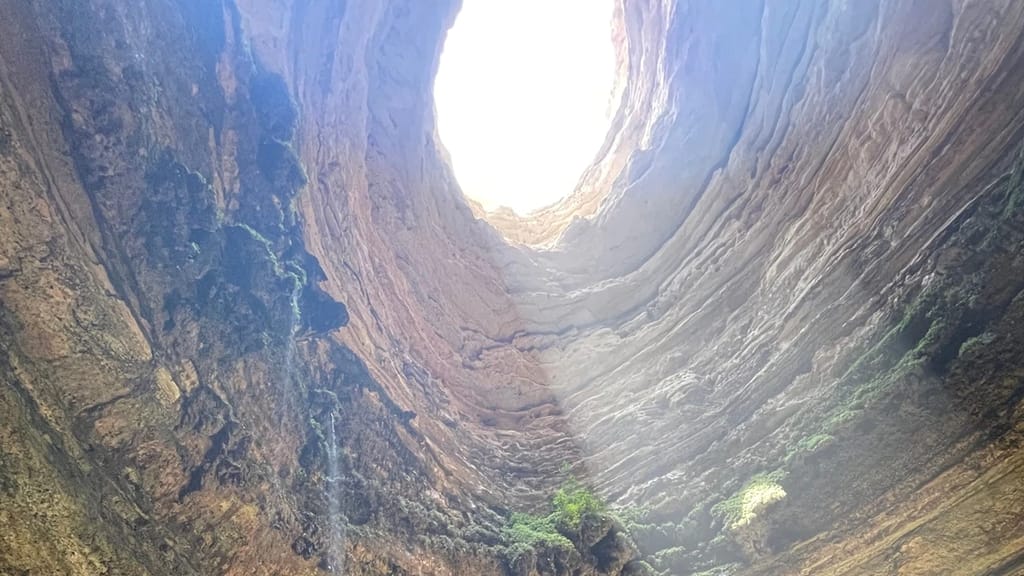A group of Omani cavers has reportedly made the first plunge to the bottom of Yemen’s mythical Well of Barhout. Yemen’s Well of Hell is a natural wonder. But many people despise it who believe it is a genie prison.
The forbidding ‘Well of Hell,’ whose dark, round aperture creates a 30-meter (100-foot) wide hole in the desert floor of Yemen’s eastern province of Al-Mahra, plunges approximately 112 meters (367 feet) below the surface. According to some accounts, it emits strange odors too.
The Oman Cave Exploration Team (OCET) discovered snakes, dead animals, and cave pearls inside, but no supernatural activity.
“There were snakes. But they won’t bother you unless you bother them,” Mohammed al-Kindi, a geology professor at the German University of Technology in Oman, told AFP.
Last Monday, Kindi was one of eight expert cavers who rappelled down. Two others remained on the surface.
Cave formations and grey and lime-green cave pearls, produced by dripping water, were seen in footage released to AFP.
“Passion drove us to do this, and we felt that this is something that will reveal a new wonder and part of Yemeni history,” said Kindi. Kindi also owns a mining and petroleum consultancy firm.
“We collected samples of water, rocks, soil, and some dead animals but yet to have them analyzed,” he said. Also, adding that a report will soon be out to the public.
“There were dead birds, which does create some bad odors, but there was no overwhelming bad smell.”
Yemeni officials told AFP in June that they had never reached the bottom of the pit. They are “millions and millions” of years old.
Despite the sinkhole’s repute as a genie prison, cavers discovered only snakes, dead animals, and cave pearls.
“We have gone to visit the area and entered the well, reaching more than 50-60 meters down,” Salah Babhair, director-general of Mahra’s geological survey and mineral resources authority, said at the time. “We noticed strange things inside and also smelled something strange… It’s a mysterious situation.”
Yemen’s Well of Hell: Sinkholes and collapse holes
But, exactly, what is the ‘Well’? The cave is actually a sinkhole, according to geographical classification. “There are different types of sinkholes,” Philip van Beynen, a sinkhole expert at the University of South Florida told Live Science.
“The most common are collapse and subsidence sinkholes.” Collapse sinkholes form when voids in the bedrock beneath the surface increase to the point where the roof above them can no longer hold them, the rock and overlaying sediment collapse into the cave. Surface sediments eventually seep down into microscopic spaces beneath the ground. It is until a depression or sinkhole emerges, according to van Beynen.
According to the Omani daily Muscat Daily, as the OCET team descended into the sinkhole, they saw an uneven and jagged floor covered in stalagmites. Some of which reached 30 feet (9 meters) in height. Cave pearls, a type of speleothem, were also found on the floor. Speleothems are cave structures, such as stalagmites and stalactites. They form by the gradual build-up of minerals, such as calcium carbonate, from dripping water.
Over the years, legends have spread about nefarious beings known as jinns or genies living in the well, Also, some believe to be the entrance to hell. For fear of bad luck, many locals are apprehensive about visiting the big pit or even talking about it.
Yemenis have already had their fair share of bad luck. Since 2014, the country has been engulfed in a deadly civil war. It has triggered what the UN calls the world’s worst humanitarian crisis, with two-thirds of its 30-million population relying on aid.
